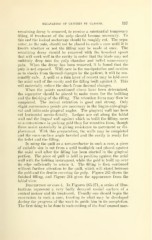Page 421 - My FlipBook
P. 421
EXCAVATION OF CAVITIES BY CLASSES. 187
remaining decay is removed, to receive a substantial temporary
filling, if treatment of the pulp should become necessary. To
this end the incisal anchorage should be roughly cut. The sepa-
rator, as the rule, should not be placed in such a case until it is
known whether or not the filling may be made at once. The
remaining decay should be removed with the broadest spoon
that will work well in the cavity in order that the blade may not
suddenly drop into tlie pulp chamber and inflict unnecessary
pain. When the decay has been removed, it is found that the
pulp is not exposed. With care in the manipulation and caution
as to shocks from tliermal changes by the patient, it will be rea-
sonably safe. A quill or a thin layer of cement may be laid over
the axial wall of the cavity and the filling built against it. This
will materially reduce the shock from thermal changes.
When the points mentioned above have been determined,
the separator should be placed to make room for the building
and the finishing of the filling. The retention form may then be
completed. The incisal retention is good and strong. Only
slight convenience points are necessary in the linguo-axio-gingi-
val and labio-axio-gingival angles. The gingival wall has been
cut horizontal mesio-distally. Ledges are cut along the labial
wall and the lingual wall against which to build the filling, more
as a convenience in packing gold than for retentive form, though
these assist materially in giving resistance to movement or dis-
placement. With this preparation, the walls may be completed
and the cavo-surface angle beveled and the cavity is ready for
the toilet and the filling.
In using the quill as a non-conductor in such a case, a piece
of suitable size is cut from a quill toothpick and placed against
the axial wall after the filling has been started in the gingival
portion. The piece of quill is held in position against the axial
wall with the holding instrument, while the gold is built up over
its edge sufficiently to retain it. The filling is then continued
without further attention to the quill, which will stand between
the gold and the dentin covering the pulp. Figure 263 shows the
finished filling, and Figure 264 gives the appearance from the
labial view.
Description of case 4. In Figures 265-271, a series of illus-
trations represent a very badly decayed mesial surface of a
central incisor and its treatment. Usually one should begin the
excavation in such a case, trusting to what may be developed
during the progress of the work to guide him in its completion.
The first thing to be done is such cutting of the frail enamel mar-


